
Learn a proven method to get brand new dancers hooked on WCS in 15 minutes, enjoy their first social dance, and sign up for classes
How to Teach WCS in 15 minutes
So new students get hooked and come back
A mini-course for
West Coast Swing teachers
First impressions are everything!
When someone expresses interest in learning West Coast Swing,
you want to make sure you give them the best possible initiation to the dance, right?
But there are so many ways that initial experience could go wrong,
and you risk losing their interest:
As a teacher, you don’t want to waste this opportunity!
You want them to have a positive experience
so they are inspired and motivated to sign up for classes!
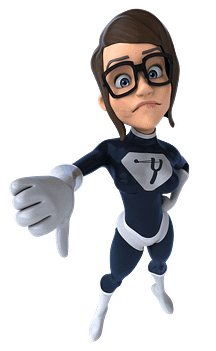

Get our proven formula
Want to know exactly what to teach to set them up for success so you can “seal the deal”?
In this short multi-media course, we’ll teach you exactly how we use progressive skill development to teach a brand new dancer (one-to-one) enough real West Coast Swing in 15 minutes so they can survive and thrive at their first social dance, and get hooked enough to sign up for classes.
This mini-course is based off the 5-day Teachers' Challenge you may remember from August 2021. It includes all the resources and videos from the Challenge.
Register now to get instant access
You can complete at your own pace in about 5 days at 30min per day, but you get access to the mini-course for 1 year.
Here are just a few success stories from teachers who tried this method...


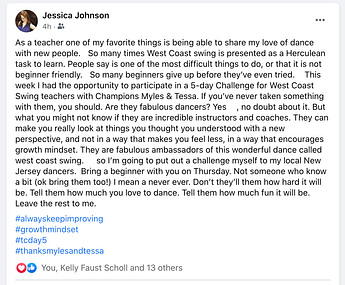
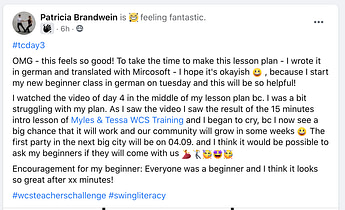
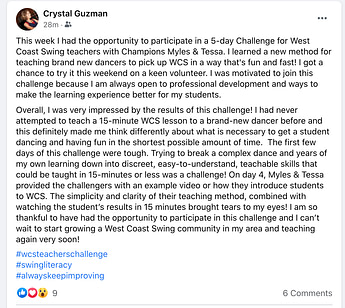


An educator's review
Heidi dezell
I recently completed Myles & Tessa’s “How to Teach WCS in 15 minutes” and wanted to give my feedback. As a longtime member of the WCS community, I also have a degree in education and spent almost 20 years in Educational Technology. I know how difficult it is to create content for an online platform that is not just e-text or a video demonstration, neither of which are educationally beneficial to most people.
This program is refreshingly different. It incorporates sound teaching techniques in both the design and in the delivery of the material. Videos are scattered throughout the program at different points in different lessons, sometimes introducing a concept and sometimes as a summary. Teaching strategies such as KWL and Scaffolding are used to help the learner. Content is delivered in short, easy to digest chunks with clear instructions on how to complete simple tasks that will move your learning along.
The program introduces and encourages teaching dance through an exploratory/discovery method…. all while using the same exploratory/discovery method to teach you how to teach! With almost 20 years of experience working with educational technology (McGraw, Pearson, Blackboard, etc), I can honestly say that this is an incredibly well-designed program, and I can’t wait to start the next series!
Register now to get instant access
Get a sneak peek
Here's a <2min video showing us presenting the 15-min lesson as demonstrations in front of teachers, live in-person. But this mini-course is 100% online so you don't have to wait to see us in person to get access to this training!
What makes the Swing Literacy method different?
Immediate results
I had a wonderful teaching experience last night with a group of dancers I only get to teach a few times per year. After giving them some of the core Swing Literacy skills, I noticed a dramatic difference in their quality of movement right away; and so did they! Their eyes were wide, and those 'aha moment' smiles ... The students were blown away by how differently the dance felt to them. I'm still getting messages this morning ..lol. Talk about positive reinforcement as a teacher ![]() ❤
❤

First time trying Swing Literacy with a newcomers workshop
First of all it was a lot of fun for me teaching the class with a different approach than how I learned to dance WCS myself a few years ago. There was more interaction with the students than I’ve seen at other beginner classes.
(The recommended drills and sequence)... were not only a lot of fun but also worked great... in no time it looked like they were dancing West Coast Swing even though it was a simpler version. Everyone was on time, followers waited to be led, and they found it easier to pick up new patterns. Nobody looked at their feet, not once! I danced with the followers and really loved their connection, it really felt like a WCS connection already.
The group was small, but definitely not everybody extremely talented, and still everybody seemed to be able to dance WCS passes that look and feel like WCS within an hour. Definitely will use more of this concept for my next beginner workshop :-) - Miranda Lam

Before the retreat, I was really frustrated - I didn’t know what or how to practice. But thanks to the systematic and cooperative coaching from M&T, I could feel improvement after my first hour on the first day. Instead of guessing what they think I am asking about, M&T are patient in trying to figure out what I’m confused about, and accommodating for my learning style and level of understanding. I now feel clarity and confidence in knowing what’s possible: what I can do and where I can go.

Delivering missing critical skills
I feel as though in other intensives, instructors will demonstrate patterns and strategies, but will not connect these to the basic skills that are required to perform these patterns/strategies. Myles and Tessa do a fantastic job explaining what prerequisite skills are required to compete the task at hand, and that helps people catch onto the material SO MUCH quicker.
We have a huge class of dancers (especially leaders) who are missing critical skills in their dance, trying to perform patterns and strategies in which they don't have the underlying/supporting skills for. Swing Literacy focuses specifically on filling those gaps in dancers' skill base. I definitely attribute MUCH of my success to your teaching style of skills before patterns.

Superpower for dancing with Beginners
Last week a young man, who had participated in the beginner class sat off to the side intently watching as the social dance began. I could see that he was literally “drinking it all in”!
When I heard a song with a simple clear beat come on I asked him if he would like to dance.
He was nervous & concentrating SO hard while using the “step back lead and step out of the slot” techniques he learned in class. But then he began to relax, then smile- then break out in a big grin!
This is where having Swing Literacy training and insight led to ME having MY BEST dance of the evening!
Because this young man was “on top of the world” & had a complete change of demeanor at his success.
His eyes shone and he began to talk to others sitting near him.
What a treasure it is to share someone's first real social dance.

My new students are progressing faster
Looking back, I wish I would have learned about the simple physics of the dance when I first started. I can see now that these foundational concepts really lay the groundwork for more complex topics and ideas. Many of my brand new students are already accelerating past those who have been dancing for years simply because they understand the core fundamentals of what each role is required to provide.

Swing Clubs investing in their teachers
Two WCS dance groups in the Atlanta area have had their instructors (and some of the practice assistants) take the Swing Literacy Teacher Training. I know for certain that one of the clubs paid for their teachers to take the training. As a result of this, there is a notable difference between the teaching styles and methods of the teachers who have taken the training and teachers (primarily teaching for other groups) who have not (and notable difference in the improvement of their students).
In addition, the training has changed the approach to beginner lessons, and progression through the beginner series. Both the students and the teachers have benefitted from this Swing Literacy Teacher Training. And, the teachers are able to use the training when they teach private lessons, so it is another benefit to them. -Linda DeGutis

Peerless Diagnostician
The Fast Track Coaching program the best thing I’ve ever done for my dance. Tessa is a peerless diagnostician. I swear it’s like her eyes see dance in slow-mo X-ray. She once told me to stop curling my toes while dancing… when I was wearing boots at the time!! Her teaching methodology is absolutely impeccable. She doesn’t just list concepts; she teaches you how to practice and learn dance so that you can retain the information. Most of my biggest breakthroughs in dance are thanks to Tessa and the more I learn about this dance the more I realize how right she is about basically everything. She got me out of Novice and now she’s gotten me out of Intermediate. The plateaus in my dance not-so-oddly coincide with the periods of time when I was working with her less regularly.

I’ve had plenty of diagnoses but have never been told how to make the corrections. I always felt confused by classes and workshops that alluded to some techniques, but never really went into detail about them. It made such a difference to have M&T give us a succinct language to communicate skills and techniques. Not only did they give me the coaching I need to understand how to make those corrections, but the clarity and consistency of their method gave me the structure I needed to reinforce concepts and build new habits.

Helped me to fill in gaps and resolve conflicting advice
I often feel like other teachers can’t answer all my questions, but with M&T, I am never afraid they won’t be able to answer my questions. I feel safe asking about a conflict in my knowledge and trust that they will straighten me out and never leave me with any lingering confusion or cognitive dissonance. Before working with M&T, I knew I had lots of gaps in my foundation. I feel like M&T poured the water in that filled all the gaps. Their method allowed us to integrate the old info with the new info - I finally got all my random dots of knowledge connected. M&T have developed an awesome system to be able to assess wherever I’m at, and meet me there to build a plan designed for me.

I owe it to my students
Learning how best to convey these concepts to students was golden. The assignments were very demanding as you actually have to apply what you learned instead of simply regurgitate it. I’d recommend this to anyone wanting to teach WCS and give your students the best possible chance of coming out of the series with solid fundamentals that make sense no matter what direction WCS takes down the road. If I only had access to these concepts back when first I started I wouldn’t be in the position of having to retrain my body to unlearn years of reinforced bad habits. I feel I owe it to my students to give them the best available information and convey it in the most understandable way I can. I strongly recommend this course.

Invaluable Investment!
I am so thankful I invested in the Swing Literacy Development Method. Myles and Tessa have put together a wealth of teaching resources and strategies for learning the fundamental movement skills of west coast swing. The course material, assignments, video clips, and practicum component were as developed and in-depth as college courses I have taken online.
I was especially impressed by and grateful for the detailed, personalized feedback I received. Tessa read through each and every assignment and included multiple comments and suggestions throughout, as well as answered any questions I had. This course has given me the confidence to know that I am presenting my students with all the tools they need to dance west coast swing authentically.
I have already had great feedback from students telling me that they are finally learning connection, elasticity, and other vital techniques that often get skipped in other classes. Everyone should be looking to improve how they teach WCS, and this comprehensive program is the way to go!

Mind blown
“I absolutely love Myles and Tessa’s approach to teaching. In just the first hour I spent with them, so many light bulbs were set off that I had to stop so I could start trying to keep track. They have a sincerity about them that I really appreciate. They’re really intent on helping me not just become a better dancer, but to understand what makes me a better dancer. It’s some of the best stuff you could hope to get from a teacher.”

Understanding the how and the why
“On a personal level, Tessa and Myles have both personally helped me move beyond my limits. They are encouraging as teachers, their collective knowledge of movement and dance, and sheer experience shines through in their interaction. Their private lessons are effective, but be prepared to work: their analysis and attention to details leave no stone unturned. They move beyond the monkey-see-monkey-do by presenting the concepts behind the ideas, reinforcing the foundations beneath the help you want. Be prepared to walk away from these guys a better dancer!”

Novice to Advanced in 6 events
"Life before Myles and Tessa was frustrating!!! I loved going to dance events, however I was doing poorly in competition, and was not exactly the most popular dancer on the social floor. After a 2-year streak of rarely making finals in novice, I started taking regular private lessons with Myles & Tessa. I jumped from Novice to Advanced in just 1 year (6 events)!!
M&T have taken years to analyze this dance and have figured out how to simplify some very complex ideas. Their Swing Literacy system is brilliant. I can see many more “Tessons” and “Mylestones” in my future."

10x your learning
"Working with Myles and Tessa has changed my entire perspective on how I look at not just West Coast Swing but all Dancing in general. As someone who has spent years practicing and thousands on lessons I can honestly say that working with M&T is one of the easiest and most efficient ways to learn how to dance. What I would spend 10 privates on with another instructor they can not only teach in a single lesson, but get to me a point where I am far more confident in my understanding of the subject. They have taught me to look into the how and why a dance works and allowed me to not only fix my own bad habits in WCS but also in my Ballroom as well. Thank you so much M&T for all of your dedication to not just dance but to the art of teaching it as well."

Transformed my community
I loved it. I thought the way it was presented and how it flowed was good for how I learn. I think it took me longer to complete because I would read articles and then mull over them and try to think how that worked or changed the way I would teach. It was very rewarding to me and my students did notice the change overnight. It’s helped me learn to engage my students more and organize my thoughts with a more natural progression for the dance. I get so tired of lecture type teaching with zero questions. I want my students to think more for themselves and know earlier about the hows and whys.

Way better than "winging it"!
I felt like this program gave me a very solid way to break down concepts, and gave me a solid sequence which is easy to stick to in each lesson. This also helped increase my confidence as a teacher a lot, because I used to just try to "wing it" and teach based on what I saw, and this program helped me have a good idea for what elements I should be teaching right away. It also encouraged me not to shy away from more advanced concepts for beginners, which I felt like has allowed me to teach better, keep students interest better, and produce students that are doing the dance better.

Guided Independence
“What I love about lessons with Tessa is her really interesting way of teaching. She never says : “Stop thinking, just do this shape like that because I told you to”. Instead, she takes the time to ask you the right questions to guide you to think for YOURSELF about your dance. This self-analysis makes me understand my own body mechanics, and learn even faster! Now every time I leave the ballroom, it’s always with a big smile because I had a lot of fun and also because I discovered something new about my way of dancing. It’s always like a revelation.”

Way beyond initiation training
I really enjoyed the Swing Literacy Teacher Development Program and strongly recommend to anybody who wants to get even more professional as a professional teacher - and even as just a dancer - the lessons helped a lot to gain a deeper understanding of how to approach a West Coast Swing Dance class - thanks to Myles and Tessa for their efforts, especially the almost instant feedback to questions and assignment gradings.

An educator's perspective
As a full-time educator, it is vital for me to have a solid, hierarchical framework of the topic or skill that I am teaching. Although I was a competent dancer who was already familiar with Myles and Tessa's teaching style when I started the SLDM, I did not have the level of expertise or the time needed to confidently build my own framework, particularly since teaching a physical skill is very different from teaching an academic one. While my teaching skills did give me a distinct advantage, the SLDM Theory Module acted as my textbook and gave me the foundation of this framework, while also teaching me how to effectively expand and build on it. It gave me the confidence and knowledge that I needed to be able to teach with professional integrity.

Observing a Swing Literacy newcomers workshop
"I recently had the privilege to assist in large back-to-back newcomer (brand new to WCS) workshops. The first workshop employed the Swing Literacy teaching method, and the next workshop used the more traditional method. Having studied both methods, I expected the Swing Literacy method to work better, but I was not prepared for just how effective it was and how quickly it worked.
During the Swing Literacy segment of the newcomers’ workshop, I noticed the students were able to perform many of the skills to a level I would typically expect from more experienced dancers. Dancing with newcomers and being able to feel their elasticity and having them connect to me like an intermediate dancer was definitely a surprising experience: t was easy and enjoyable - it wasn't a chore or struggle to dance with them. I observed them smiling, laughing, keeping their eyes up, and focusing on their partners. After the workshop was over, I was impressed that they were able to sustain these skills as they practiced on their own.
The traditional-method workshop was taught by very experienced and lovable teachers, but about 10 minutes in, the atmosphere in the room changed. I noticed that the students started struggling: the usual frustrations that go along with learning dance for the first time were back. I had one couple ask me for help with the patterns that were being taught, and the leader refused to dance until he could figure out his own steps. At this point he was so frustrated that no matter what I did, whether breaking down the pattern or asking him to ignore the pattern and just dance had no effect. He was already too stressed out to dance or learn at this point: a common problem that I have seen in many classes.
When I danced with the Newcomers in the traditional workshop, many of their skills that made our dances enjoyable for me during the Swing Literacy workshop had disappeared: they stopped their momentum, they stopped using elasticity, their heads were down, looking at their own feet, and they were all focused on trying to do the patterns instead of leading or following.
As someone who has both danced and taught WCS for years I found myself a little confused during the traditional method workshop - I can only wonder how much the Newcomers must have been struggling at that point. From my personal experience during these workshops I would definitely say that the Swing Literacy method taught WCS in a way that newcomers could easily understand and allowed them to not only progress faster but also to enjoy their experience far more than the traditional method of teaching." -Glenn Clark

Making complex ideas simple
Rather than telling our students exactly where their feet need to be, we are providing them with the fundamental principles of the dance. This is helping my students achieve a pure lead-follow dance rather than choreographed footwork and patterns.
I have tried this in many of my group classes thus far, and it has been very well received! Many students have approached me and told me that they love how I am teaching complex ideas, but at the same time making them simple to understand.

I never knew it could be like this!
When I signed up for this program, I expected a what-to-do training session; how to teach the basics, and in what order. To my surprise, they didn’t give us any of this information. Yes, there was a metric ton of materials provided, but they gave us the tools to answer these questions for ourselves.
This was not a lesson in how to replicate Myles & Tessa in dance, or in teaching style. In fact, they avoided preaching subjective, personal opinions like the plague. This was a lesson in how to break down complex material into manageable building blocks, and how to scaffold learning in order to give the student the best possible shot at retaining the material. I learned to question everything, myself, and *why* something works or does not work. I learned that while a student must experience success to feel compelled to learn more, there are alternatives to teaching pattern footwork to a beginner in order to give them a manageable task. Many alternatives!
I learned how to shape a more credible WCS dancer in their first 15 minutes, and how to convey the key underlying WCS techniques with relatable analogies and simple drills. This is the tip of the iceberg. Myles & Tessa, you are truly masters of your trade. I am so grateful to have you both as my coach, mentor and dance project manager. Thank you!

Faster progress with students even without contact
Yesterday I taught a private for the first time since COVID started. I've been teaching this couple more or less consistently since they started 18 months ago.
The couple and I were wearing masks and were in a huge room with open windows, at least 10m apart on different sides of the room. So obviously I couldn't dance with/touch them in order to demonstrate anything. I taught them Swing Literacy fundamentals and discovered they could handle more than I thought. And: it made a big difference! They were able to understand the techniques behind the moves so much better, and I was able to explain the technique way clearer. I think before I much more had to rely on being able to dance with them and make them feel certain movements in addition to explaining some concepts. It was also easier for me to identify what was missing in their dancing, so issues were easier to fix. Their underarm turns, sugar pushes and inside turns looked so much better afterwards!! Thank you, Myles and Tessa, for putting together this invaluable training program!

Connects all the loose ends from multiple teachers
This is different from any other learning format, and is an opportunity to be exposed to a new way of learning WCS. It is strategic and very well communicated. It keeps you motivated and accountable. It also provides you a sense of Community with others that are like minded. SL is different in that it starts with the foundation and builds from there, as opposed to my past experience, where a multitude of teachers and lessons were constructing a dancer with spackle. Takes all the loose ends from multiple teachers and weaves them into a comprehensive approach that supports the learning process.

Courage to step out of the box
I had a gut feeling that things should be taught a different way - Swing Literacy gave me the courage to step out of the box of the old school teaching methodology. It gave me affirmation, guidance, courage, valildation. It reinforced my dedication to the concept of drills & skills over patterns & footwork, and I realized what was critical both to focus on and to avoid focusing on.

Uniquely creating an environment where people connect
Over the years, one thing has consistently stood out to me: their workshops are far more than just dance lessons. Myles and Tessa bring an unmistakable energy and a deep passion for the dance that transcends technical skills.
When they step onto the dance floor, the world seems to pause for a moment. They create an environment where people connect, not only with each other but also with themselves. This is especially remarkable in a time when we all rush through life, with little time for relaxation. But with Myles and Tessa, there is space—space to learn, grow, and enjoy together.
What sets them apart from other instructors is their approach. While many dance teachers focus on teaching impressive moves or refining styling and technique, Myles and Tessa take a different path. They emphasize the connection between the dancers, regardless of their different backgrounds and personalities. Whether you're a beginner or advanced, everyone comes with the same goal: to become a better dancer and have a great time on the floor.
In their workshops, they highlight the essence of dancing together: you’re not just dancing for yourself, but also for your partner. Their method makes you aware of how you can adjust to each other, so both of you can enjoy the moment. This creates a deeper connection and fosters joint development, both as individuals and as dancers. It’s not just about the steps; it’s about finding harmony in movement and experience.
The beauty of their approach is that they bring dance back to its roots: a way to connect with others and with yourself. They remind us that dance is a social, physical, and emotional journey. You move, you connect, and you grow on multiple levels. West Coast Swing, in particular, is a special dance form because it also evolves, partly thanks to the ever-changing music.
For anyone looking to learn West Coast Swing on a deep fundamental level, their Swing Literacy Development Program provides the most complete and perfect source. Whether you're aiming for social dancing, competitions, or simply personal growth in your dance, their method offers a solid base to grow with.

"I am a firm believer that you can not learn a dance without a consistent, progressive curriculum, that having classes at random, from different instructors and on different levels is disorienting, like picking crumbs from a table. You guys are brilliant, this is exactly what I needed and was waiting for. And, all your efforts to constantly add-on, adjust, upgrade are so much appreciated! Thank you!"

Gave my instincts a logical structure
Up until this course, I had a mish-mash of information and concepts drawn from various teachers and from my own experience, but I didn't have a logical, consistent structure to provide a framework for it all. This is absolutely going to me give me more confidence (much needed), as now I feel like I know what I'm talking about.

Doubled our numbers in 2 months
As an Advanced dancer and I had been teaching for a few years now with no real training. I’d been looking for something to help grow our community and my knowledge as a teacher. I’d always felt like I could learn more, but hadn’t found any learning programs that were West Coast Swing based teaching.
When I started the Swing Literacy program, literally within the first week my students noticed a dramatic change in my teaching methods. I continue to get compliments from them comparing my teaching early on to where I am today.
Prior to me taking the Swing Literacy TDP, we always wanted something more and knew that we lost people. Since finishing and implementing Swing Literacy methods, we are able to retain many more people and grow the dancers we already have. Our community probably doubled during the first few months of using the new program! My AllStar teaching partners are excited to take the TDP too, inspired by the difference it has made for me and our community.

The gold standard of WCS teaching
Myles & Tessa’s Swing Literacy Program is the gold standard of teaching to me. It’s so much more than a workshop - it’s a complete package that I can’t imagine teachers teaching without. They don’t teach you “their style”, or any style for that matter: they train you in actual pedagogy and how to build a solid foundation of physical skills (not just patterns) that gives students the best possible shot at “getting it” quicker and getting addicted. It helped me get over my imposter syndrome - I feel more confident in my teaching and I see massive improvement in the dancers in our community.

Changed my approach
This course helped me to discover missing elements as both a student and as an instructor. We have all wondered why some things are more difficult to learn. The Swing Literacy program changes the way you extrapolate and helps you plan your next steps in a much more "engineering viewpoint."
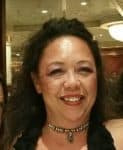
The science behind teaching dance
It's like having a world class teacher - who happens to be a dancer - give you the secrets you need to know to be an effective, creative, inspirational, and inspiring teacher. It isn't just about dance... its the science behind teaching others.

Best teaching method I've ever experienced
Best teaching method I've ever experienced (and I've completed 22 years of formal schooling!) It's like having the reference book on everything WCS PLUS the physical drills, feedback and supportive learning community!

Most comprehensive teaching program available
Myles and Tessa emphasize the need for a serious, professional approach to teaching dance. The stakes of teaching dance are at least as high as being a physical trainer or coach because the student's ego and emotional well-being are even more at risk in dance than in other non-dance physical training. Therefore they advocate and teach a caring and professional approach that includes correctly given feedback, lesson plans, syllabus, and continuing education.
To support that vision, Myles and Tessa have created extensive material to aid the WCS teacher, including an extensive syllabus, an online discussion forum, and an invaluable bank of planning and assessment materials. All of these tools are available to empower the aspiring dance teacher to grow the dance community by recruiting and retaining new dancers.

Register now to get instant access
Copyright © 2025 SwingLiteracy.com - All rights reserved